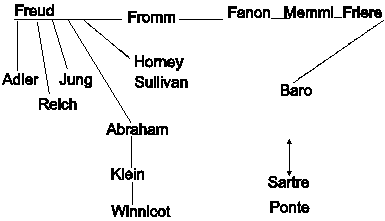On Liberation of Being (dr. watkins)
The history of psychotherapy is that it is for the rich. In actuality, psychotherapy needs to reflect on the ways that the status quo is reinforced, that is, how the poor are kept in culturally specific forms of suffering.
1) From what do we suffer? • Why these maladies in our communities? Think locally. • What feelings, thoughts, and perceptions do you have and what do they say about the situation you are in? 2) What are our methods or processes of healing? • Understand where suffering comes from first before you can heal it • What needs to be restored? • Follow your biography and let your awareness be deepened through theory 3) How do we engage in our visions of the desired? Looking at Freud’s method: Free Association (like IMPROV) he was attempting to “abandon the conscious purpose of ideas with the known” as an “antidote to directed attention.” His goal was for the client to develop mobile attention, to allow unthought thoughts to arise, Bola called this the “unthought known” (for Freud, this was usually around sex and aggression) to release the body from holding the symptom. Symptoms are interesting in that they both reveal and conceal at the same time. He made a choice, because of the culture he lived in, to reframe incestuous memories as desires instead of memories. This caused psychotherapy to become conservative: he “fit it into the culture” instead of letting the truth be known because the effect would have been overwhelming in the culture he lived in. In your fieldwork how can you listen with mobile attention? Don’t filter what you are hearing or what you can allow yourself to know from a cultural perspective – in other words, don’t do what Freud and Jung did. Don’t prematurely narrow your field of understanding. Be “not knowing” while listening. OK to sort into categories but keep the freshness of experience: hold theory lightly! We discussed the following theorists since Freud:
The point is to widen consciousness in the “non-heroic ego” state (but not a porous ego state, either) to “drain the swamp” which conditions one for creativity. As in free writing exercises, let your attention go beyond like/dislike. CHORUS OF STONES How do you hear Freud in “Chorus of Stones” in terms of process? Susan Griffin is courageously writing in free association style. The major problem that Chorus brings to our awareness is DENIAL of the problem. The ways we practice our denial has an impact in the world. Winnicott pulls together bits and pieces and tries to fill in the gaps with the assumption that we know more than we think we know. Our hearts are hardened. Mimmi says both the colonizer and the colonized are hardening their hearts, are psychically numbing themselves. It is more difficult to love. How are we mutilated? How is our heart hardened? Ask these questions. Reference “Common Shock” by Cathy Weingarten: We can be traumatized even though we are not present in the colonized or traumatic situation. Griffin is asking us to use our body and mind to work things out for the community – your biography is a social one. Trace it to find the connections to your community. “DENIAL colors all” “The problem is having secrets. Secrets revealed will lift the heaviness.” We are history. Our private lives are public events. Ask yourself, “where am I numb?” What we want to tell, maybe no one wants to know. But it will strike you like a terrorist attack after years of denial. Connect what is personal with the larger context. Jeff made a comment about “false stories” that cover the truth, but that there are bits and pieces of truth in false stories. Marta revealed the disappearance of her cousin in Mexico because he was involved in political activities as a guerrilla and this was a family secret. JUNG “Autonomy of Psyche outside of ego self”. “Spontaneous thoughts”. Active imagination is different than free association. You stare and concentrate on an image and allow yourself to be in conversation with it. Mystics did this with deities. It requires forming an active relationship with contents of the dream which requires a repositioning of the ego away from the center. You enter the world of the image – you really feel something. In an activity you observe, participate, relate. Hillman calls it the “imaginal ego” where you treat the psychic entity as real. “We are dreaming all the time”. Hillman was not afraid of psychosis, as was Jung. He said to form a relationship with the psychosis and the practice alone is healing if you do nothing else. Hillman says to listen to the voices in archetypal psychology. The difference between psychotic voices is that they overwhelm you and tell you what to do. But the voices in active imagination are dialogical (involve a two-way conversation). Active imagination was introduced in the middle of analysis so that the patient had the tools to continue the work on their own when the analysis was done. REICH His idea of character armoring was acceptable to Freud, but then Reich got more political and talked about the mental harm of sexual repression, became active in birth control education, and worked with the body (which was “off the chart” in Vienna at that time). Read “Fury on Earth” the biography of Reich. Reich worked with the body to bring the unconscious out through it, which also requires the ego to be out of the way. He believed in the free flow of bodily energy (keyword: Free Flow) and though pleasurable experiences were blocked by structural “clamping down” of energy. All of these approaches are about liberation of being.
Fromm discussed the “cultural unconscious”.
Horney was wildly popular and kicked out of the Psychoanalytic Society.
Freiro was exiled from Brazil.
Baro was assassinated in El Salvador.
